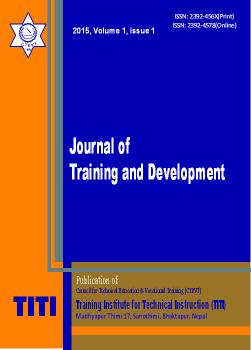Introducing Technical & Vocational Education and Training (TVET) in the Secondary Schools in Nepal: Opportunities and Challenges
DOI:
https://doi.org/10.3126/jtd.v1i0.13083Keywords:
Technical and Vocational Education and Training, Secondary schools, Quality, Employability, PilotingAbstract
Nepal's education sector is striving for producing quality human resources for the country. However, due to lack of appropriate policy, priority and curricula, the efforts have been less effective. Education sector has also been a subject of criticism due to mismanagement of the 'products' and the industry demands. Taking these matters into considerations, Government of Nepal is trying to introduce the TVET in secondary education (9-12) system as a pilot-basis. This article has explored some of the critical issues associated with the intention of introducing TVET, its demand and supply-sides debates, challenges as well as opportunities in expanding TVET in Nepalese secondary education system. Literature review, some expert-interviews and reflection of personal experiences are the key methods of information generation for this article. The main conclusion of this article is that the TVET system in Nepal has very high demand to produce the required and quality human resources in Nepal. There are ample opportunities in introducing the expanding of TVET in Nepal. However, key learning from 99-piloted schools should be main basis to take further steps visualizing the feasibility, employability and sustainability from students, schools, and schools' perspectives. Even after the School Sector Reform Program (SSRP), the initiative of introducing TVET in all secondary schools of Nepal should continue.
DOI: http://dx.doi.org/10.3126/jtd.v1i0.13083
Journal of Training and Development Vol.1 2015: 3-8
Downloads
Downloads
Published
How to Cite
Issue
Section
License
Authors who publish with this journal agree to the following terms:
- Authors retain copyright and grant the journal right of first publication with the work simultaneously licensed under a Creative Commons Attribution License that allows others to share the work with an acknowledgement of the work's authorship and initial publication in this journal.
- Authors are able to enter into separate, additional contractual arrangements for the non-exclusive distribution of the journal's published version of the work (e.g., post it to an institutional repository or publish it in a book), with an acknowledgement of its initial publication in this journal.
- Authors are permitted and encouraged to post their work online (e.g., in institutional repositories or on their website) prior to and during the submission process, as it can lead to productive exchanges, as well as earlier and greater citation of published work (See The Effect of Open Access).




